Comprehensive Report on Ayurveda: Origins, Applications, and Safety
VerifiedAdded on 2023/05/28
|6
|1240
|383
Report
AI Summary
This report provides a comprehensive overview of Ayurveda, a 5000-year-old system of natural healing originating in the Vedic period. It discusses the increasing demand for alternative medicine, particularly herbal products, and the widespread use of Ayurvedic medicines for various clinical conditions like anxiety, asthma, and high blood pressure. The report highlights potential risks associated with Ayurveda, including adverse reactions, lead contamination in traditional cosmetics, and toxicological aspects of herbo-metallic compounds. It also touches upon food and drug interactions as described in ancient texts. The author emphasizes the lack of research supporting the effectiveness of Ayurvedic medicine, recounting a personal experience with a cancer patient who relied on Ayurvedic treatment without success. The report concludes by advocating for evidence-based research and patient education to ensure appropriate treatment regimens. Desklib provides access to this and other student-contributed assignments.
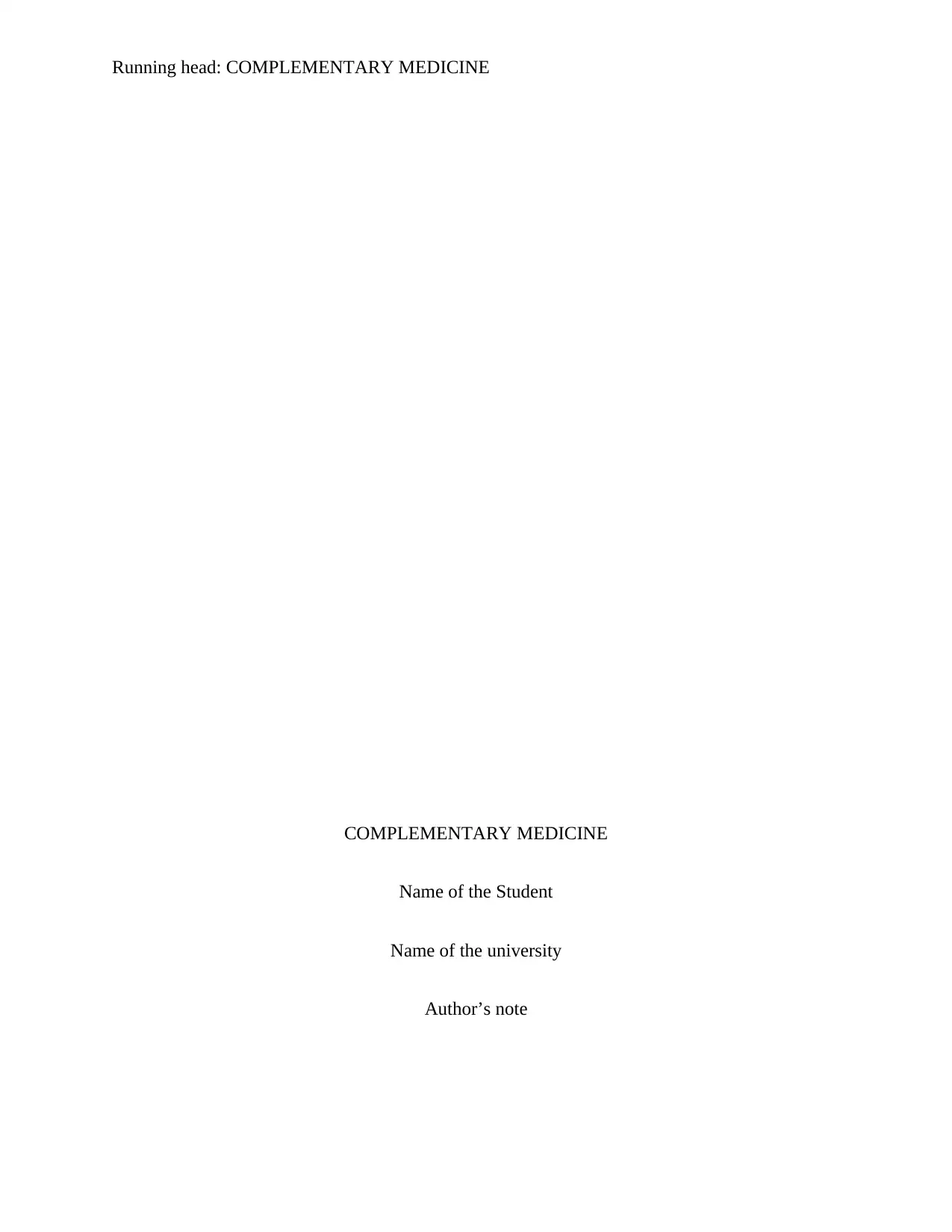
Running head: COMPLEMENTARY MEDICINE
COMPLEMENTARY MEDICINE
Name of the Student
Name of the university
Author’s note
COMPLEMENTARY MEDICINE
Name of the Student
Name of the university
Author’s note
Secure Best Marks with AI Grader
Need help grading? Try our AI Grader for instant feedback on your assignments.
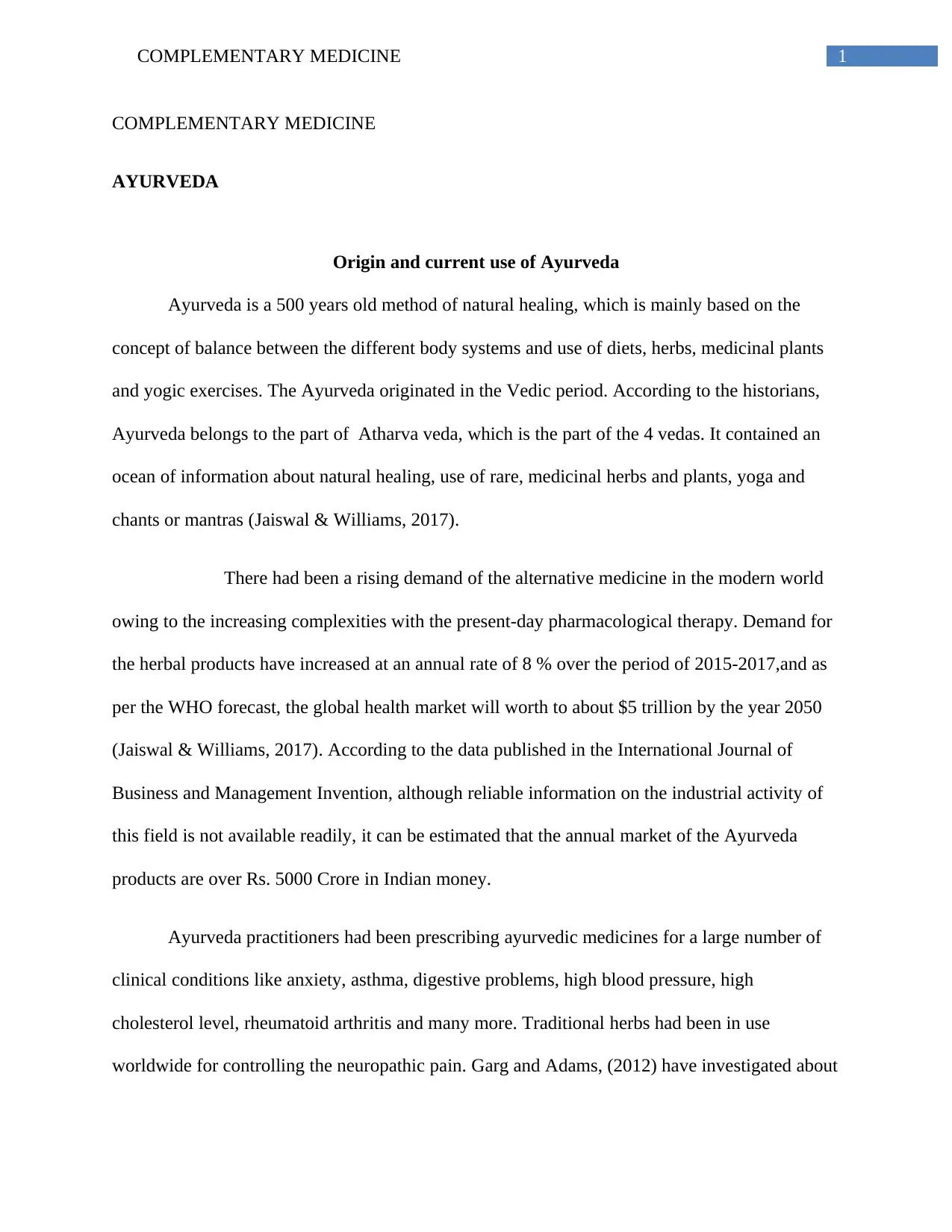
1COMPLEMENTARY MEDICINE
COMPLEMENTARY MEDICINE
AYURVEDA
Origin and current use of Ayurveda
Ayurveda is a 500 years old method of natural healing, which is mainly based on the
concept of balance between the different body systems and use of diets, herbs, medicinal plants
and yogic exercises. The Ayurveda originated in the Vedic period. According to the historians,
Ayurveda belongs to the part of Atharva veda, which is the part of the 4 vedas. It contained an
ocean of information about natural healing, use of rare, medicinal herbs and plants, yoga and
chants or mantras (Jaiswal & Williams, 2017).
There had been a rising demand of the alternative medicine in the modern world
owing to the increasing complexities with the present-day pharmacological therapy. Demand for
the herbal products have increased at an annual rate of 8 % over the period of 2015-2017,and as
per the WHO forecast, the global health market will worth to about $5 trillion by the year 2050
(Jaiswal & Williams, 2017). According to the data published in the International Journal of
Business and Management Invention, although reliable information on the industrial activity of
this field is not available readily, it can be estimated that the annual market of the Ayurveda
products are over Rs. 5000 Crore in Indian money.
Ayurveda practitioners had been prescribing ayurvedic medicines for a large number of
clinical conditions like anxiety, asthma, digestive problems, high blood pressure, high
cholesterol level, rheumatoid arthritis and many more. Traditional herbs had been in use
worldwide for controlling the neuropathic pain. Garg and Adams, (2012) have investigated about
COMPLEMENTARY MEDICINE
AYURVEDA
Origin and current use of Ayurveda
Ayurveda is a 500 years old method of natural healing, which is mainly based on the
concept of balance between the different body systems and use of diets, herbs, medicinal plants
and yogic exercises. The Ayurveda originated in the Vedic period. According to the historians,
Ayurveda belongs to the part of Atharva veda, which is the part of the 4 vedas. It contained an
ocean of information about natural healing, use of rare, medicinal herbs and plants, yoga and
chants or mantras (Jaiswal & Williams, 2017).
There had been a rising demand of the alternative medicine in the modern world
owing to the increasing complexities with the present-day pharmacological therapy. Demand for
the herbal products have increased at an annual rate of 8 % over the period of 2015-2017,and as
per the WHO forecast, the global health market will worth to about $5 trillion by the year 2050
(Jaiswal & Williams, 2017). According to the data published in the International Journal of
Business and Management Invention, although reliable information on the industrial activity of
this field is not available readily, it can be estimated that the annual market of the Ayurveda
products are over Rs. 5000 Crore in Indian money.
Ayurveda practitioners had been prescribing ayurvedic medicines for a large number of
clinical conditions like anxiety, asthma, digestive problems, high blood pressure, high
cholesterol level, rheumatoid arthritis and many more. Traditional herbs had been in use
worldwide for controlling the neuropathic pain. Garg and Adams, (2012) have investigated about
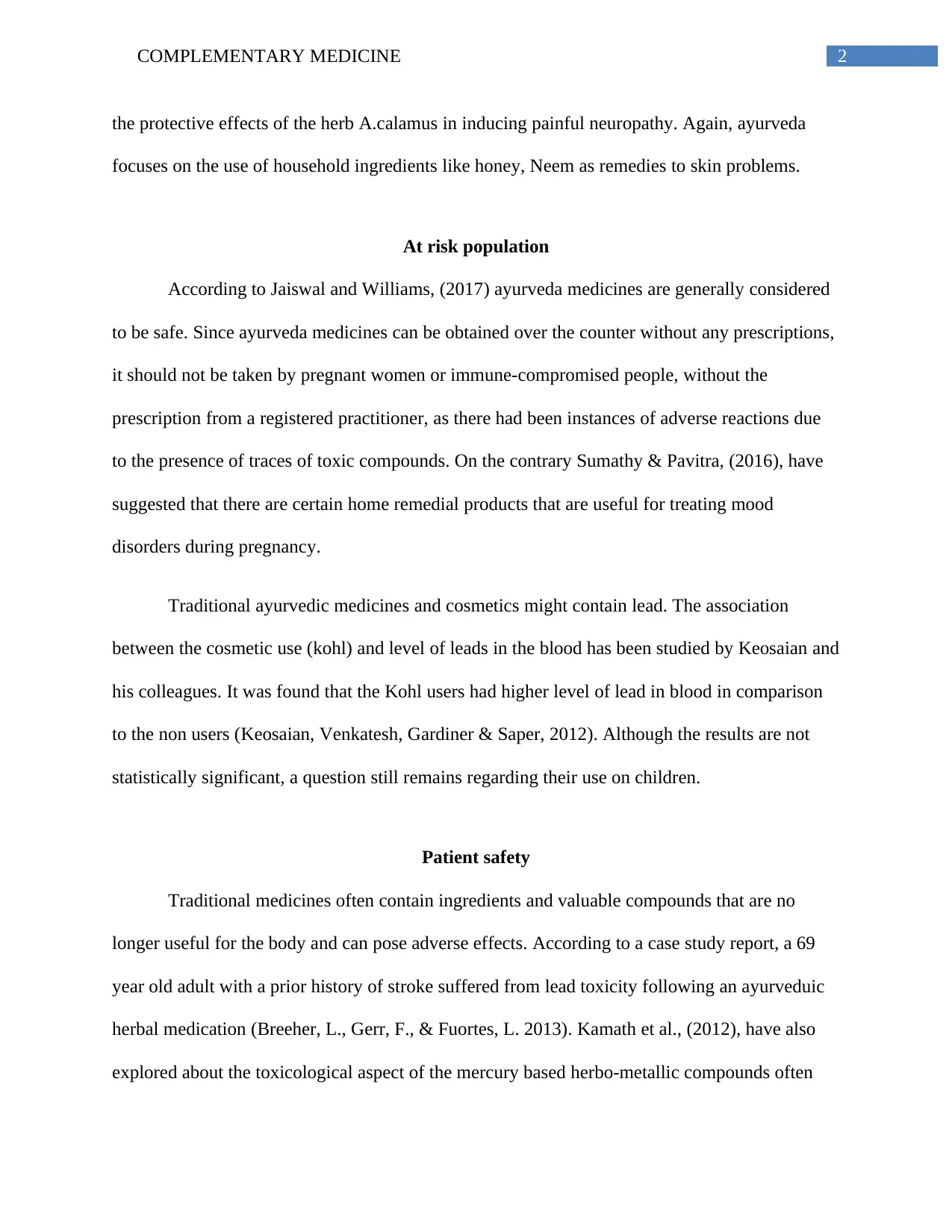
2COMPLEMENTARY MEDICINE
the protective effects of the herb A.calamus in inducing painful neuropathy. Again, ayurveda
focuses on the use of household ingredients like honey, Neem as remedies to skin problems.
At risk population
According to Jaiswal and Williams, (2017) ayurveda medicines are generally considered
to be safe. Since ayurveda medicines can be obtained over the counter without any prescriptions,
it should not be taken by pregnant women or immune-compromised people, without the
prescription from a registered practitioner, as there had been instances of adverse reactions due
to the presence of traces of toxic compounds. On the contrary Sumathy & Pavitra, (2016), have
suggested that there are certain home remedial products that are useful for treating mood
disorders during pregnancy.
Traditional ayurvedic medicines and cosmetics might contain lead. The association
between the cosmetic use (kohl) and level of leads in the blood has been studied by Keosaian and
his colleagues. It was found that the Kohl users had higher level of lead in blood in comparison
to the non users (Keosaian, Venkatesh, Gardiner & Saper, 2012). Although the results are not
statistically significant, a question still remains regarding their use on children.
Patient safety
Traditional medicines often contain ingredients and valuable compounds that are no
longer useful for the body and can pose adverse effects. According to a case study report, a 69
year old adult with a prior history of stroke suffered from lead toxicity following an ayurveduic
herbal medication (Breeher, L., Gerr, F., & Fuortes, L. 2013). Kamath et al., (2012), have also
explored about the toxicological aspect of the mercury based herbo-metallic compounds often
the protective effects of the herb A.calamus in inducing painful neuropathy. Again, ayurveda
focuses on the use of household ingredients like honey, Neem as remedies to skin problems.
At risk population
According to Jaiswal and Williams, (2017) ayurveda medicines are generally considered
to be safe. Since ayurveda medicines can be obtained over the counter without any prescriptions,
it should not be taken by pregnant women or immune-compromised people, without the
prescription from a registered practitioner, as there had been instances of adverse reactions due
to the presence of traces of toxic compounds. On the contrary Sumathy & Pavitra, (2016), have
suggested that there are certain home remedial products that are useful for treating mood
disorders during pregnancy.
Traditional ayurvedic medicines and cosmetics might contain lead. The association
between the cosmetic use (kohl) and level of leads in the blood has been studied by Keosaian and
his colleagues. It was found that the Kohl users had higher level of lead in blood in comparison
to the non users (Keosaian, Venkatesh, Gardiner & Saper, 2012). Although the results are not
statistically significant, a question still remains regarding their use on children.
Patient safety
Traditional medicines often contain ingredients and valuable compounds that are no
longer useful for the body and can pose adverse effects. According to a case study report, a 69
year old adult with a prior history of stroke suffered from lead toxicity following an ayurveduic
herbal medication (Breeher, L., Gerr, F., & Fuortes, L. 2013). Kamath et al., (2012), have also
explored about the toxicological aspect of the mercury based herbo-metallic compounds often
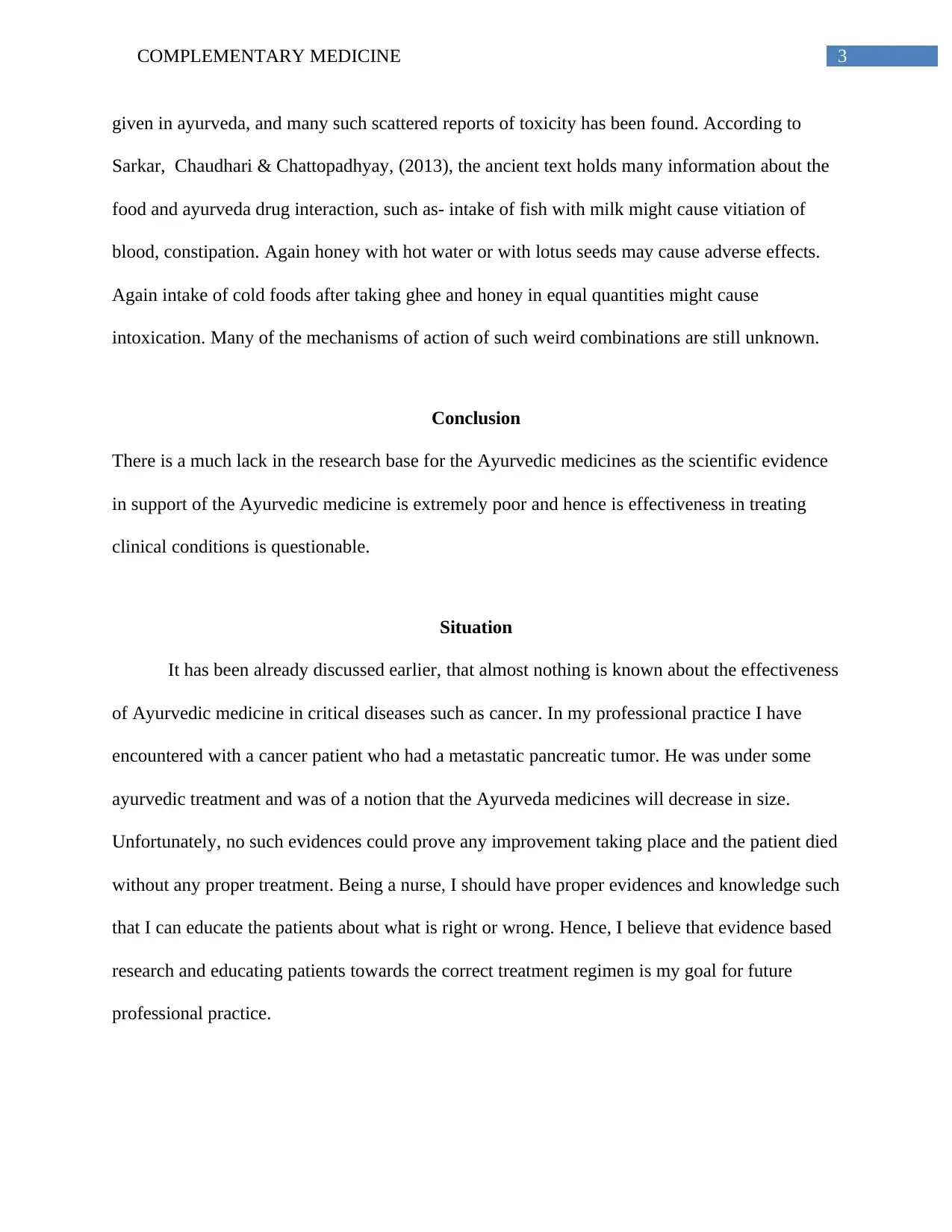
3COMPLEMENTARY MEDICINE
given in ayurveda, and many such scattered reports of toxicity has been found. According to
Sarkar, Chaudhari & Chattopadhyay, (2013), the ancient text holds many information about the
food and ayurveda drug interaction, such as- intake of fish with milk might cause vitiation of
blood, constipation. Again honey with hot water or with lotus seeds may cause adverse effects.
Again intake of cold foods after taking ghee and honey in equal quantities might cause
intoxication. Many of the mechanisms of action of such weird combinations are still unknown.
Conclusion
There is a much lack in the research base for the Ayurvedic medicines as the scientific evidence
in support of the Ayurvedic medicine is extremely poor and hence is effectiveness in treating
clinical conditions is questionable.
Situation
It has been already discussed earlier, that almost nothing is known about the effectiveness
of Ayurvedic medicine in critical diseases such as cancer. In my professional practice I have
encountered with a cancer patient who had a metastatic pancreatic tumor. He was under some
ayurvedic treatment and was of a notion that the Ayurveda medicines will decrease in size.
Unfortunately, no such evidences could prove any improvement taking place and the patient died
without any proper treatment. Being a nurse, I should have proper evidences and knowledge such
that I can educate the patients about what is right or wrong. Hence, I believe that evidence based
research and educating patients towards the correct treatment regimen is my goal for future
professional practice.
given in ayurveda, and many such scattered reports of toxicity has been found. According to
Sarkar, Chaudhari & Chattopadhyay, (2013), the ancient text holds many information about the
food and ayurveda drug interaction, such as- intake of fish with milk might cause vitiation of
blood, constipation. Again honey with hot water or with lotus seeds may cause adverse effects.
Again intake of cold foods after taking ghee and honey in equal quantities might cause
intoxication. Many of the mechanisms of action of such weird combinations are still unknown.
Conclusion
There is a much lack in the research base for the Ayurvedic medicines as the scientific evidence
in support of the Ayurvedic medicine is extremely poor and hence is effectiveness in treating
clinical conditions is questionable.
Situation
It has been already discussed earlier, that almost nothing is known about the effectiveness
of Ayurvedic medicine in critical diseases such as cancer. In my professional practice I have
encountered with a cancer patient who had a metastatic pancreatic tumor. He was under some
ayurvedic treatment and was of a notion that the Ayurveda medicines will decrease in size.
Unfortunately, no such evidences could prove any improvement taking place and the patient died
without any proper treatment. Being a nurse, I should have proper evidences and knowledge such
that I can educate the patients about what is right or wrong. Hence, I believe that evidence based
research and educating patients towards the correct treatment regimen is my goal for future
professional practice.
Secure Best Marks with AI Grader
Need help grading? Try our AI Grader for instant feedback on your assignments.
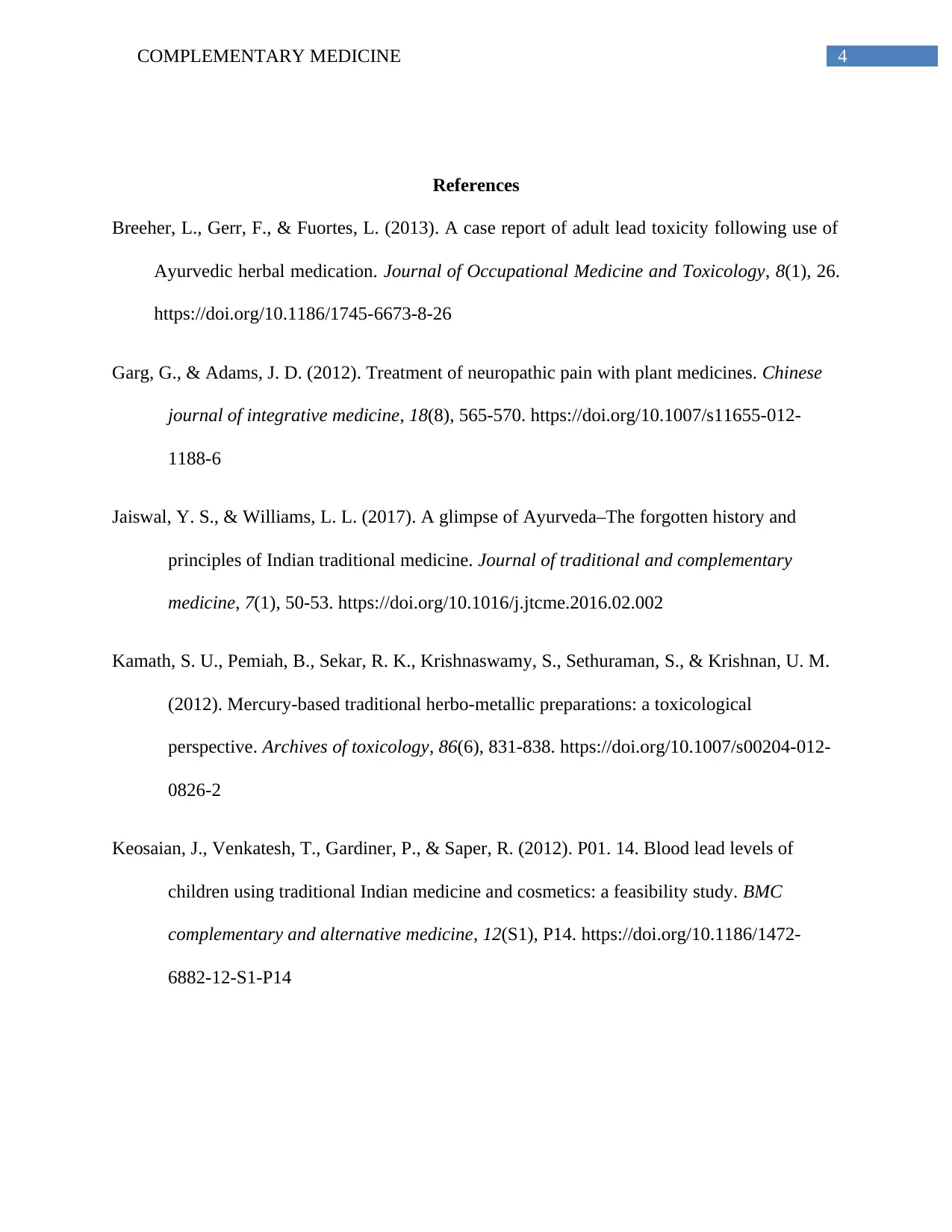
4COMPLEMENTARY MEDICINE
References
Breeher, L., Gerr, F., & Fuortes, L. (2013). A case report of adult lead toxicity following use of
Ayurvedic herbal medication. Journal of Occupational Medicine and Toxicology, 8(1), 26.
https://doi.org/10.1186/1745-6673-8-26
Garg, G., & Adams, J. D. (2012). Treatment of neuropathic pain with plant medicines. Chinese
journal of integrative medicine, 18(8), 565-570. https://doi.org/10.1007/s11655-012-
1188-6
Jaiswal, Y. S., & Williams, L. L. (2017). A glimpse of Ayurveda–The forgotten history and
principles of Indian traditional medicine. Journal of traditional and complementary
medicine, 7(1), 50-53. https://doi.org/10.1016/j.jtcme.2016.02.002
Kamath, S. U., Pemiah, B., Sekar, R. K., Krishnaswamy, S., Sethuraman, S., & Krishnan, U. M.
(2012). Mercury-based traditional herbo-metallic preparations: a toxicological
perspective. Archives of toxicology, 86(6), 831-838. https://doi.org/10.1007/s00204-012-
0826-2
Keosaian, J., Venkatesh, T., Gardiner, P., & Saper, R. (2012). P01. 14. Blood lead levels of
children using traditional Indian medicine and cosmetics: a feasibility study. BMC
complementary and alternative medicine, 12(S1), P14. https://doi.org/10.1186/1472-
6882-12-S1-P14
References
Breeher, L., Gerr, F., & Fuortes, L. (2013). A case report of adult lead toxicity following use of
Ayurvedic herbal medication. Journal of Occupational Medicine and Toxicology, 8(1), 26.
https://doi.org/10.1186/1745-6673-8-26
Garg, G., & Adams, J. D. (2012). Treatment of neuropathic pain with plant medicines. Chinese
journal of integrative medicine, 18(8), 565-570. https://doi.org/10.1007/s11655-012-
1188-6
Jaiswal, Y. S., & Williams, L. L. (2017). A glimpse of Ayurveda–The forgotten history and
principles of Indian traditional medicine. Journal of traditional and complementary
medicine, 7(1), 50-53. https://doi.org/10.1016/j.jtcme.2016.02.002
Kamath, S. U., Pemiah, B., Sekar, R. K., Krishnaswamy, S., Sethuraman, S., & Krishnan, U. M.
(2012). Mercury-based traditional herbo-metallic preparations: a toxicological
perspective. Archives of toxicology, 86(6), 831-838. https://doi.org/10.1007/s00204-012-
0826-2
Keosaian, J., Venkatesh, T., Gardiner, P., & Saper, R. (2012). P01. 14. Blood lead levels of
children using traditional Indian medicine and cosmetics: a feasibility study. BMC
complementary and alternative medicine, 12(S1), P14. https://doi.org/10.1186/1472-
6882-12-S1-P14
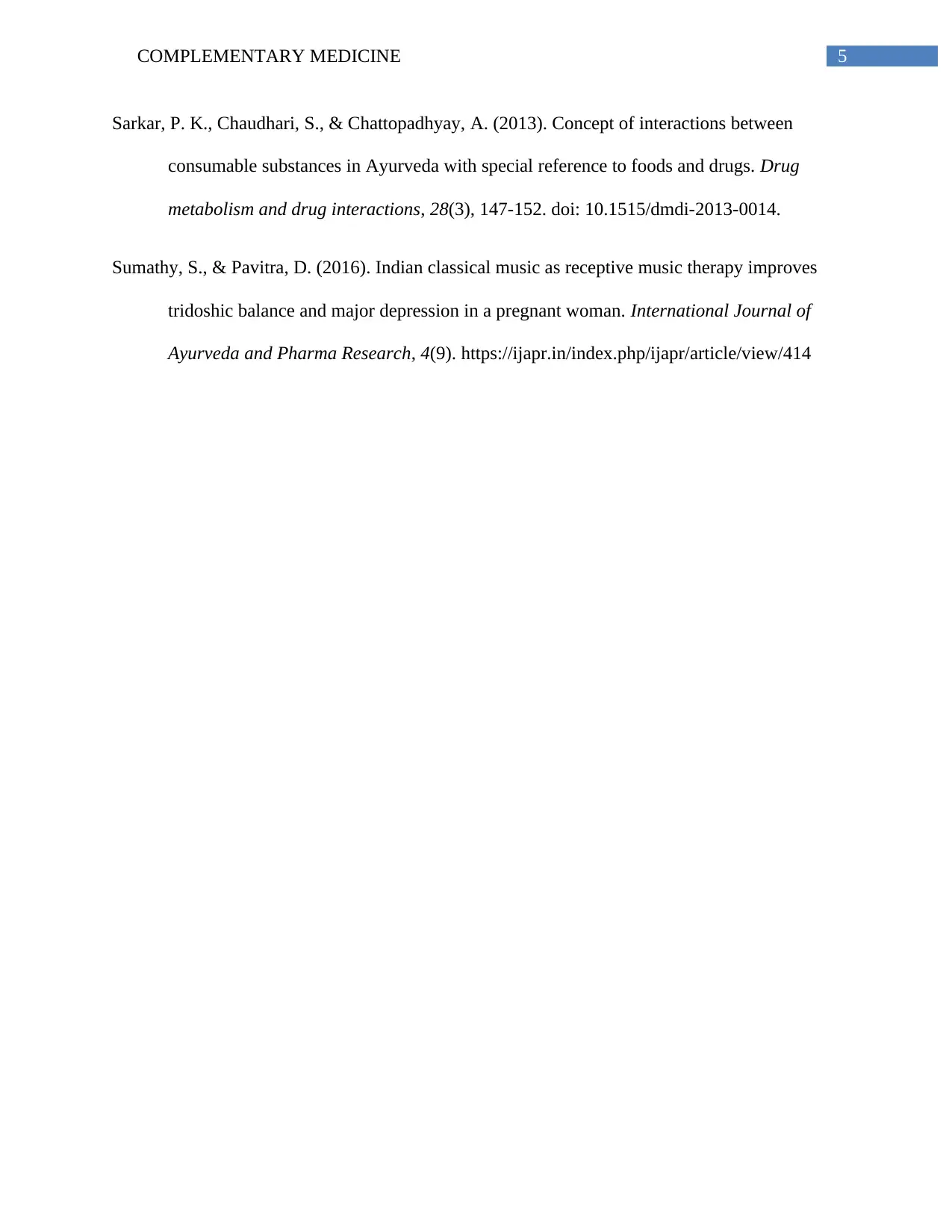
5COMPLEMENTARY MEDICINE
Sarkar, P. K., Chaudhari, S., & Chattopadhyay, A. (2013). Concept of interactions between
consumable substances in Ayurveda with special reference to foods and drugs. Drug
metabolism and drug interactions, 28(3), 147-152. doi: 10.1515/dmdi-2013-0014.
Sumathy, S., & Pavitra, D. (2016). Indian classical music as receptive music therapy improves
tridoshic balance and major depression in a pregnant woman. International Journal of
Ayurveda and Pharma Research, 4(9). https://ijapr.in/index.php/ijapr/article/view/414
Sarkar, P. K., Chaudhari, S., & Chattopadhyay, A. (2013). Concept of interactions between
consumable substances in Ayurveda with special reference to foods and drugs. Drug
metabolism and drug interactions, 28(3), 147-152. doi: 10.1515/dmdi-2013-0014.
Sumathy, S., & Pavitra, D. (2016). Indian classical music as receptive music therapy improves
tridoshic balance and major depression in a pregnant woman. International Journal of
Ayurveda and Pharma Research, 4(9). https://ijapr.in/index.php/ijapr/article/view/414
1 out of 6
Your All-in-One AI-Powered Toolkit for Academic Success.
+13062052269
info@desklib.com
Available 24*7 on WhatsApp / Email
![[object Object]](/_next/static/media/star-bottom.7253800d.svg)
Unlock your academic potential
© 2024 | Zucol Services PVT LTD | All rights reserved.